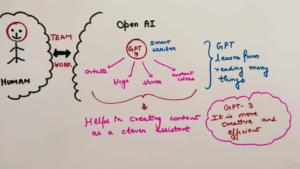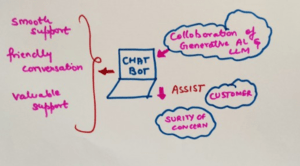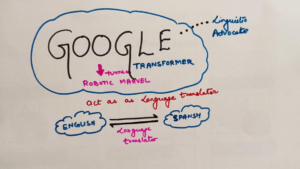Introduction
Let’s dive into the cool world where smart machines get creative and understand lots of words. This magical partnership between Generative Artificial Intelligence (AI) and Large Language Models (LLMs) has changed how we use technology. They team up to do amazing things like talking like us, writing stuff, and solving problems. In this article, we’ll take a closer look at how Generative AI and LLMs work together, with real examples showing their super teamwork.
Understanding Generative AI and Large Language Models
Imagine a smart robot that can create things on its own – that’s Generative AI. Now, think of another robot that’s really good at reading and understanding tons of words – that’s the Large Language Model. When these two robots join forces, they can make human-like text. This team-up helps with language tasks like translating, making content, and even writing computer code.
Real-world Case Studies and Examples
OpenAI’s GPT-3 in Content Creation
OpenAI’s GPT-3 is like a super-smart writer on the internet. It can write all sorts of things, like articles, blogs, and stories, almost like a computerized storyteller. People use it to save time because it’s like having a clever assistant that never gets tired.
Imagine GPT-3 as a digital artist that knows a lot about words and how to put them together. It can create different types of writing on many topics, making it a helpful tool for various needs.
What makes GPT-3 special is that it learned a lot from reading many things. This learning helps it understand how language works, what words mean, and even how to use grammar correctly. So, when people ask it to write something, it can do it in a way that makes sense and sounds good.
People use GPT-3 when they need help with writing, like making blog posts regularly, writing essays for school, or coming up with ideas for stories. GPT-3 becomes a helpful sidekick that makes writing easier and quicker.
The cool part is that GPT-3 can adjust its writing style based on what people want. It’s like having a writing assistant that listens to instructions and creates content just the way you want it.
As we explore more about smart machines and how they work with humans, GPT-3 shows us what’s possible. It’s not just a tool for writing; it’s a partner that helps us be more creative and efficient. The teamwork between people and GPT-3 paints a bright picture of how machines and humans can work together to make exciting things happen in the world of writing and creativity.
Consider a scenario where you can have a friendly conversation with a computer, just like you would with a pal. This remarkable experience is crafted by the collaboration of Generative AI and Large Language Models (LLMs) within customer support chatbots. Major companies employ these conversational robots to promptly assist customers and ensure their concerns are acknowledged.
Here’s how it works: Generative AI and LLMs team up to make these chatbots intelligent. They comprehend what people are saying and respond in a way that makes sense, resembling the way a good friend would communicate. This capability allows companies to efficiently handle a large volume of customer questions and issues without causing delays.
Imagine encountering an issue with a recently purchased product, like a new phone. You type a message, and the chatbot on the company’s website engages with you. It might say, “Hello! I’m here to assist you. What seems to be the problem with your phone?” This interaction is akin to having a knowledgeable friend who can guide you towards a resolution.
These conversational robots continuously learn from numerous interactions, enhancing their abilities over time. They adapt to what works well and what doesn’t, ensuring a smoother customer experience. Consequently, companies can provide assistance to more individuals simultaneously, guaranteeing that everyone receives the support they require.
In essence, chatbots fueled by Generative AI and LLMs serve as friendly aides for prominent companies. They transform the interaction with a computer into a friendly conversation, delivering prompt and valuable support whenever it is needed. This synergy benefits both customers and companies – customers receive the assistance they seek, while companies efficiently address the needs of everyone.
Code Generation with OpenAI Codex
Codex, a close companion to GPT-3, possesses an impressive ability to grasp the intentions of a programmer. When you convey what you desire your computer program to accomplish, Codex steps in and crafts the necessary code on your behalf. This proves to be immensely beneficial for numerous individuals, streamlining the coding process significantly. It’s akin to having an intelligent assistant well-versed in the language of computers, translating your concepts into functional code.
This not only simplifies the coding experience but also serves as a time-saving and efficient solution for those engaged in programming tasks.
Language Translation with Google’s Transformer
Imagine Google’s Transformer as a linguistic superhero, possessing an exceptional skill for seamless translation. This robotic marvel not only understands but also adeptly converts words from one language to another, with the primary aim of enriching communication and fostering mutual understanding, especially among speakers of different languages.
In practical terms, if you have a piece of text in English that you wish to translate into Spanish, Google’s Transformer takes center stage, performing its transformative feat. It skillfully translates the words, making them accessible and intelligible for individuals conversant in Spanish. This simplifies the exchange of ideas, information, and stories, facilitating a deeper connection for those engaging in cross-linguistic conversations.
Fundamentally, Google’s Transformer assumes the role of a linguistic advocate, dismantling language barriers and facilitating effective communication across diverse linguistic backgrounds. It operates as a linguistic virtuoso, ensuring that everyone can freely articulate their thoughts and ideas, transcending the challenges presented by language variations.
Content Summarization and Information Extraction
In the world of smart technology, these intelligent robots take on the task of reading lengthy articles for us. Their special skill? They sift through the content and pinpoint the most crucial information.
What’s even better is that they can create brief summaries, saving us from having to read the entire article. It’s like having a fast and efficient method to grasp the main idea from large pieces of writing without the need for extensive reading.
Conclusion
When these intelligent robotic systems collaborate, the impact is not trivial; it constitutes a substantial advancement. By scrutinizing tangible instances, it becomes evident how these systems significantly streamline processes such as content creation, human-computer interaction, and linguistic problem-solving. As their cognitive capabilities continue to advance, one anticipates further innovations arising from the synergistic partnership between Generative AI and Large Language Models, thereby enhancing the utility and user-friendly nature of technology for a broad spectrum of users.





